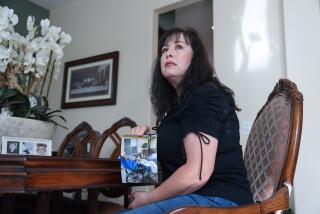Asking patients to help shoulder malpractice costs
When his malpractice insurance premiums jumped 65% last year, Dr. Alan Falkoff felt as if he were running out of options. The family physician couldn’t keep paying such hikes and still stay in business. Then he had an idea.
The Stamford, Conn., doctor decided to charge his patients a mandatory $3 “medical malpractice” fee.
“There is a risk of a lawsuit with every patient I see, so I don’t see why patients shouldn’t share a small amount of that burden,” Falkoff said.
A small but growing number of doctors around the country agree. To combat rising malpractice insurance bills, they’re requiring that patients chip in to cover their costs.
In many cases, the debit takes the form of a voluntary surcharge, typically $10 to $25, because the government bars doctors from charging Medicare patients extra fees.
Still, a number of privately insured patients -- and the uninsured -- are being required to pay the fees, which the patients’ insurance won’t cover.
Other doctors are taking even bolder steps, but stop short of making the charges mandatory. Earlier this year, Ira Warshaw of North Palm Beach, Fla., sent a letter to 3,000 of his patients asking for an annual $125 donation ($25 for those younger than 25) to help him pay his malpractice insurance. In the letter, the family physician said he might have to stop seeing Medicare and some HMO patients if he didn’t raise enough money.
Nearly a third of his patients responded, sending in a total of $75,000. “This is a way for patients to help sustain the kind of practice they have come to appreciate,” said Warshaw, who plans to send another letter next year.
Although they are showing signs of slowing, medical liability costs have been increasing dramatically in many areas in recent years, turning the issue into a rallying cry among doctors. Malpractice coverage for an obstetrician-gynecologist in Illinois rose 67% this year to $230,000 while rates for a general surgeon in Dade County, Fla., jumped 24% to $277,000, according to the Medical Liability Monitor, a group that tracks national medical malpractice rates.
Malpractice costs have also become effective fodder in the national debate of liability reform. Saying reform will help control costs, the Bush administration and many states are pushing for caps on awards in medical negligence cases. A number of patient and consumer advocates oppose the move, as does the majority of Democratic politicians including Sen. John F. Kerry.
California already has a cap that limits malpractice awards for pain and suffering to $250,000. Although that’s kept liability rates down and given doctors here less incentive to add similar fees, “some doctors could warm up to the idea if it takes off elsewhere,” said Michael Goodman, an obstetrician in Davis.
Goodman says doctors in California are angered by the high number of lawsuits in the state and could see fees like this as a way of making patients aware of the overall costs of medical lawsuits. “To a degree, patients have brought this on themselves,” he said. “What goes around comes around.”
Rather than continue to pay their liability insurance, some specialists -- especially those in high-risk practices such as obstetrics, surgery and neurology -- are closing their practices and retiring early or moving to states with lower liability costs. A small number are dropping insurance and putting their assets in a family member’s or friend’s name to protect them if they’re sued.
“Physicians can’t carry on paying these huge jumps in premiums, especially if insurers and Medicare continue to scale back what they pay for services,” said John Nelson, a Salt Lake City obstetrician and president of the American Medical Assn. “Doctors aren’t trying to make profit off this. They’re just trying to stay in business.”
The AMA is planning to discuss guidelines for doctors who charge malpractice fees at the group’s convention in December. The California Medical Assn. says doctors can legally charge additional fees, but it recommends they notify patients of the charges before services are provided.
Consumer groups and some disapproving physicians equate malpractice fees to a money grab, and worry that doctors who force patients to pay them could be discouraging poorer patients from getting care. In some cases, those who refuse to pay the fees have been asked to find a new doctor.
Even physicians who ask for voluntary donations raise concern. “Patients may feel an undue pressure to pay the fee, either because they don’t want to anger their doctor or because they fear if they don’t, they may lose their right to sue if something untoward happens,” said Clarence Braddock, an associate professor of medicine at Stanford University’s Center for Biomedical Ethics.
Arthur Levin, director of the Center for Medical Consumers in New York, said the fact that doctors are asking patients to help pay their bills even as health costs have soared in recent years was “outrageous.” Levin points out that many physicians have already tacked on fees to patient bills in recent years for previously free services such as calling in prescription refills and filling out children’s summer camp forms. “Twenty-five dollars for someone living check to check is a lot of money,” he said.
There are those, too, who believe doctors are using the fees more as a political tool than an economic one. Tim Lambert, a family physician in Traverse City, Mich., who doesn’t agree with patient malpractice charges, says that many physicians hope the fees will heat up the issue among voters and force politicians to more seriously explore malpractice reform. “It’s certainly bad public relations for doctors. I think some are just trying to cause a fuss.”
Falkoff said a few patients had left his practice since he instituted his surcharge. But so many patients have supported him, he said, that he is planning to up the fee next year to $4 if his rates rise again. “Why can’t I try to make more money like everyone else in this country?” he said. “For me to keep my patients healthy, I have to make a living.”
More to Read
Sign up for Essential California
The most important California stories and recommendations in your inbox every morning.
You may occasionally receive promotional content from the Los Angeles Times.










